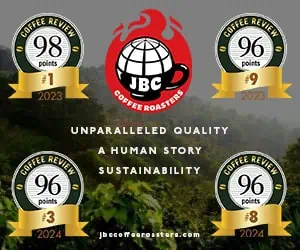LATEST REVIEWS
We have published thousands of coffee reviews and espresso reviews since 1997. The reviews below appear in reverse chronological order by review date. Older reviews may no longer accurately reflect current versions of the same coffee. To search for a specific roaster, origin or coffee use the Advanced Search Function.
One of the few coffees in the cupping with resonance and depth. You have to be patient with this coffee and wait for the heavy, pruny, dark-roast pungency to reveal itself in the finish, but it's worth the wait. If this coffee showed some acidity and top notes it might be a real winner. As it is, the attic is bare and all the fun is in the cellar, but that's probably as it should be in something called a French roast.
The acidity is powerful yet subdued, slightly (and properly, given the origin) winy. Not much depth or resonance, but a nutty sweetness emerges in the finish that surprises, given the origin. The roast contributes some slight carbon tones.
Solid, balanced, with a slightly winy acidity wrapped in a substantial body, all characteristics of a good Colombia. But again, these virtues seem attenuated. The complexity is confined to the middle registers, with both top and bottom notes pinched off. A slight sweetness fills out the profile in the finish.
A rather distinctive coffee marked by a clear, winy acidity that some would call bright and others sharp. I lean toward bright with rough edges. The acidity is so dominating that I had a difficult time reading the body: I finally concluded medium. And the broken record rasps: intriguing first impression but not much behind it.
Almost everyone remarked on a complex sweetness in this medium-bodied Huehuetenango. Some characterized the sweetness as chocolate-toned; others as caramel. Two assigned the sensations to that tantalizing cusp between chocolate and fruit. Most found the acidity sufficient to enliven the sweetness ("bright, pleasant, intriguing"), but one cupper complained that the acidity was disappointing and another that it was "puckery." There was an unusually wide range of response to body. Assessments ranged from light to (emphatically) heavy, with a consensus somewhere between medium and full. Perhaps our palates were confused by the pervasive sweetness, which can read as weight.
A powerful but flawed coffee. Coffee professionals are familiar with the taste of ferment, caused when the sugars from the coffee fruit begin to go off while the fruit is still on the bean. The result is an odd, lush sensation that can register as ripe, overripe, or occasionally (particularly as the coffee cools) rotten. Cupper's comments reflect the ambivalence that mild ferment provokes. Almost everyone noted this coffee's luxuriant, wine-like fruitiness. Six cuppers detected a clear defect, however, and five of the six identified the defect (correctly in my view) as ferment, the shadow side of the fruitiness. Only one cupper dismissed the coffee on the basis of this defect, however, and in compensation several noted spicy nuances.
Judging by the scores, I was in the minority here. I loved this Antigua for its dimension and completeness -- the way it resonated on the palate and developed, stretching into the distance behind the initial impression. Some cuppers agreed: "nice complexity ... clean, lingering aftertaste"; "full [bodied], great structure." But others wanted more out front: "all the right characteristics, but very [much] in the distance, blurry." Four detected chocolate notes; only one found a mild off note.
A provocative coffee. Everyone had something to say about it, yet no clear consensus emerged. The majority read the body as full ("even and full; well-balanced," according to one), but a small but outspoken minority found it light or even thin. Surprisingly, almost no one came down in the middle. Reactions to acidity were similarly mixed: Several found the acidity pleasantly dry and winy; others criticized it as sharp or sour. I found it alive and vivacious at first impression but rather ragged and astringent in the finish. No defects were cited; on the other hand nobody carried on about grace notes either.
For most the acidity was the main act here. Some found it pleasantly bright ("nice, winy and sharp," according to one); others complained it was too sharp, throwing off the balance of the coffee, and perhaps astringent in the aftertaste. Supporting virtue: Most found this coffee substantial in body. "An excellent example of a Guatemala," according to one. But judging from the scores, the majority may harbor reservations.
Most found this Antigua a bit underpowered, perhaps owing to its relatively light body (noted by almost everyone). Some found compensating virtues: chocolaty, spicy, nutty notes. Others praised a soft, sweet smoothness. Still others objected: "a bit lifeless"; "not so happening"; "thin"; and most Originsal, "straightlaced[!]". Only two found outright failings: a slight sourness. One delivered an inspired characterization of the subtle fragrance: "Dancing on fruity."
Defects apparently consigned this rather heavy-bodied, low-toned Antigua to the bottom of the cupping-form pile. Some found its low-toned heaviness flat; others, however, liked it. Several called the profile "sweet"; another "solid." One cupper raved: "Great cup. Very good body and flavor." Another puzzled: "Aspects don't gel, even though it has good flavor." Three cuppers detected sour notes, one going so far as to call the coffee "oniony." Three others found it old-tasting or "baggy," which suggests conditioning or storage problems, a plausible hypothesis for a coffee that suggests power but doesn't come through, that seems oddly dulled or muted.
Virtually everyone described this medium-bodied coffee as soft and sweet. About half of the cuppers reported nutty tones. Some stopped there. "Unremarkable!" exclaimed one. Several, however, also identified a light, high-toned acidity that balanced or complemented the sweetness. For example: "Pleasant soft, sweet acidity -- subtly snappy." Two cuppers detected slightly hard or woody notes in the nose of this coffee, but apparently tasted nothing to confirm the problem in the cup and chose not to push the issue in their responses.
This delicate coffee is the inverse of the San Rafael. Its virtues would seem to be softness, lightness, and buoyant top notes. Its weakness appears to be lack of power, and its faults failures of youth rather than age. Several cuppers detected floral tones. Others tasted notes ranging from spicy through herbal to nutty (the favorite, noted on three forms). Nevertheless, several cuppers were put off by shortcomings associated with immaturity: grassiness, rawness. Two detected sour notes.
Fermented notes, barely detectable in the acidy notes of the aroma, dominate in the cup, particularly as the coffee cools, turning from mild distraction to barnyard nasty.
Low-toned to the point of flatness. A hard, slightly metallic taste is the only sign of acidity. A sweet sensation that reads as vanilla in the nose and prune in the finish is the only saving virtue.
The vanilla / nut tones in the aroma fade quickly in the cup, giving way to a rather hard, characterless acidity that eventually takes on prune-like inflections in the finish.
For a moment, somewhere between nose and finish, this coffee struck me as rich with its nut and vanilla tones. But overall a thin-toned acidity dominates: an edgy, almost sour distraction without grace notes or resonance.
A sweet nuttiness dominates here, without offense but also without much intrigue or energy. The nut-like tones may harbor a hint of acidity but no grace notes and little depth or dimension.
A deep bottom with just enough acidity to keep from the coffee from imploding into dullness. Other than the rather full body I read few signs of the Colombia profile in this decent but hardly exciting coffee.
Superb aroma: full, rich, stretching from winy top notes to a deep, engaging bottom. But the wine-like East African acidity turns hard in the cup, then reveals clear fermented notes as the coffee cools. The Java component is weak, failing to provide the expansive bottom such blends call for.










